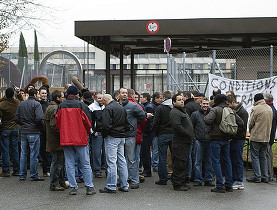
Geneva plans large new prison

After much wavering, the Geneva cantonal government has launched a project to build a new remand prison to help ease the situation at the heaving Champ-Dollon jail.
The new facility would hold a maximum of 500 detainees and could open in 2015 near Champ-Dollon, Switzerland’s most overcrowded prison, which was built for 270 detainees in 1977 and currently holds over 500.
“Overcrowding at Champ-Dollon poses problems in terms of detention conditions and work for the prison guards, not forgetting internal security problems,” Mark Muller, the canton’s minister in charge of construction, told Le Temps newspaper.
A working group is currently studying the project, in particular the location and capacity, and will present its report on May 31, to be followed by a cantonal parliamentary debate.
The government decision is a turning point, as up to now the government had hesitated over a new remand detention facility for fear it would quickly fill up.
“Everyone prefers to build schools, but there is no other solution,” Laurent Moutinot, Geneva’s justice and police minister, told the Tribune de Genève newspaper on Wednesday.
“We expected a great deal from the new penal code and the system of day-fines to help clear our remand prison system a bit. But they haven’t had any impact in Geneva.
“And despite opening the new La Brénaz prison for short sentences, Champ-Dollon is still too full. There is no more hesitation,” he added.
But the forthcoming parliamentary debate on the issue risks being lively.
Social Democrat Alberto Velasco called the government’s decision an “aberration” and said the canton was better off investing in the reintegration of prisoners and social assistants.
“Building a prison for 500 people is senseless. In two months it will be overcrowded, as nature hates empty spaces,” he told Le Temps.
Chronic overcrowding
Champ-Dollon prison today averages nearly twice as many prisoners as it was designed for. In mid-January 2009, 502 inmates were crowded into its cells.
“When we go beyond 500 detainees, we cross a psychological barrier,” Constantin Franziskakis, director of Champ-Dollon, told swissinfo. “It’s a remand prison and we have 1,500 movements a month.”
Campaigners say the overcrowding has obvious consequences for detainees’ living conditions: poor sanitation and promiscuity. It also affects access to health care and legal counsel and endangers safety.
Owing to the number of detainees and lack of work opportunities, most inmates must spend 23 out of 24 hours in their cells.
Under such circumstances it is difficult to segregate the various categories of prisoners, notably by detention regime.
“Twenty five years ago we used to house real gangsters and their violence was directed towards us,” explained Michel Demierre, the chief prison guard. “Nowadays drugs have changed everything and violence erupts among ethnic groups.”
“It’s very difficult to get Africans, Arabs and Albanians to live together. It doesn’t take much for fights to break out.”
“Conditions are getting worse,” admitted Franziskakis. “But a prison is a mirror of society.”
Strike action
In 2007 a group of experts strongly criticised conditions at Champ-Dollon, claiming the facilities were insufficient and the length of investigative custody too long. In canton Geneva 46 per cent of detainees are on remand, compared with the Swiss average of 31 per cent.
The report was commissioned by Geneva’s cantonal parliament following a mutiny at the prison in 2006 when 200 inmates threatened to go on hunger strike over alleged police brutality and slow justice.
Fed up with the difficult working conditions and insecurity, in December 2008 and January 2009 guards demonstrated outside Champ-Dollon, blocking the prison gates and threatening to go on strike.
“We have to deal with violence and fights; our work is increasingly difficult and we demand recognition,” one guard told swissinfo.
An agreement between the prison guards’ union and the cantonal government was eventually reached on January 27.
Pressure to increase the capacity of remand facilities is not new.
During her term as Geneva’s justice and police minister Micheline Spoerri launched an initiative to build an additional floor at Champ-Dollon, but the idea was dropped as the overcrowding was thought to be too risky and volatile.
If the new prison goes ahead, it will join La Brénaz, a modern SFr18 million ($20.8 million) short-sentence prison for 68 detainees that opened in January 2008 on land adjacent to Champ-Dollon.
And in 2013 the “Curabilis”, a jail for prisoners with psychiatric problems, should free up 90 additional places at Champ-Dollon.
swissinfo, Simon Bradley in Geneva
There are around 120 detention centres in Switzerland with places for 6,741 inmates.
In 2007 there was a total of 5,715 people under lock and key (-3%).
Women accounted for 6% of the prison population, and teenagers 1%.
On the office’s reference day – September 5 – 1,653 people were being held in detention. A further 3,586 were serving time, while 403 were waiting to be expelled from the country. The 73 others were being held for a variety of reasons.
Foreigners represented nearly 80% of those in detention, and more than half of these people were in Switzerland illegally. And foreign citizens accounted for nearly two-thirds of all detainees serving a prison sentence.
Champ-Dollon prison, built in 1977 to hold 270 prisoners, today averages nearly twice as many. In mid-January 2009 there were 502 detainees. Around 60% of people held there are in investigative custody.
Some 52.2 per cent are aged 20-29 and there are 108 different nationalities, or 60 different languages present. There are only 140 places in the prison workshops. As a result, detainees spend on average 23 out of 24 hours in their cells.
Every year between 1-4 prisoners commit suicide. The last successful attempt to escape from the Champ-Dollon was in August 2001.

In compliance with the JTI standards
More: SWI swissinfo.ch certified by the Journalism Trust Initiative




























You can find an overview of ongoing debates with our journalists here . Please join us!
If you want to start a conversation about a topic raised in this article or want to report factual errors, email us at english@swissinfo.ch.